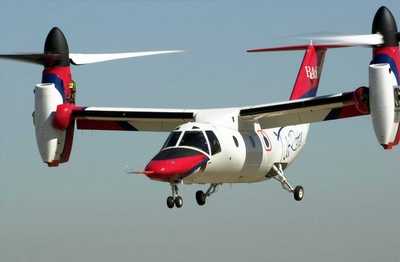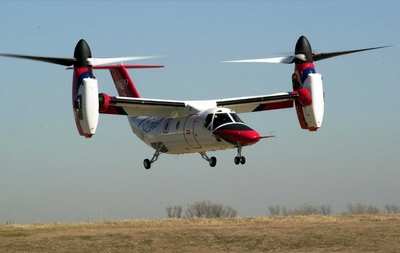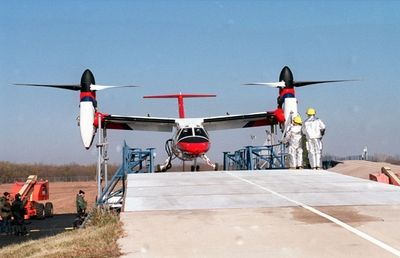First Flight Test Aircraft Undergoing Modifications
The world's first civil tiltrotor aircraft, the Bell/Agusta
BA609 begins envelope expansion flight test late this year.
Meanwhile, the first flight test aircraft is continuing to undergo
configuration modifications at Bell's Flight Research Center,
Arlington (TX), following the conclusion of the first phase of
flight testing in 2003. So far the BA609 has flown a total of nine
flights with 14 hours of flight time.

In addition, significant effort has been underway to support
aircraft #002, which is now at an Agusta assembly and flight
testing facility in Cameri, Italy, to begin its build-up for flight
test in early 2005. Aircraft #003 will be shipped to Cameri later
this year.
The dual flight test effort now supports the dual production
line in the US and Italy much sooner than earlier plans. Dual
certification (European and FAA) is planned in late 2007 with
deliveries following soon after. Bell/Agusta anticipates a second
assembly line in Italy for the BA609, so the flight test /
certification experience will also support that goal. US and
Italian aviation regulatory authorities have been very cooperative
and Bell/Agusta looks forward to their continuous rigorous review
for BA609 to obtain a Certificate of Airworthiness to Transport
Category standards.

The current order status remains strong with essentially more
than the first two years of production already committed to our
existing backlog. The BA609 continues as one of the most highly
anticipated aircraft ever, and we expect backlog to continue to
grow as flight tests continue and are completed through
certification.
During the first phase of flight testing in 2003, the
nine-passenger aircraft, jointly developed by Bell Helicopter, a
Textron company and by Agusta, an AgustaWestland company, flew in
excess of fourteen flight hours with the nacelles in the full aft
to 15 degrees forward positions. During this first phase of the
flight test program, the Bell/Agusta 609 accomplished a full range
of helicopter flight maneuvers including hovering, pedal turns,
rearward flight and forward flight up to altitudes of 5,000 feet
and 100 knots. The first flight on March 7, 2003, followed
seven weeks of ground runs and taxi testing.
Bell/Agusta says the second phase of flight testing on the 609
will begin this year with flight testing to be conducted in the
high speed airplane mode. With its rotors in the vertical position,
the tiltrotor is able to take-off, land and hover like a
traditional helicopter. When the rotors are tilted forward to the
horizontal position, the aircraft is able to fly similar to a
turboprop fixed-wing airplane. The transition from helicopter mode
to airplane mode takes 20 seconds, as does the transition from
airplane mode to helicopter mode.

The BA609, a six to nine passenger aircraft, has market
applications for corporate business, offshore operators and
government customers for a variety of roles including Search and
Rescue, and internal security team insertion. The BA609 will have
the new Collins ProLine 21 3-screen display glass cockpit as
standard, and will be certified for IFR flight in known icing
conditions. It is expected to be certified in 2007 with first
deliveries to begin immediately following. Bell/Agusta will produce
a total of four prototype tiltrotor aircraft for flight-testing in
The US and Italy.
Final assembly for production aircraft will take place at Bell's
Amarillo, Texas, facility. A second assembly line will be
established at Agusta's plant in Cameri, Italy. Fuji Heavy
Industries of Japan has the contract to build all of the production
fuselages for the BA609. All parts and components for both lines
will come from the exact same source yielding aircraft that will be
identical whether assembled in Italy or Texas.
Headquarters for the Bell/Agusta Aerospace Company is located at
Alliance Airport in Fort Worth, Texas. BA 609 customer training
will be conducted at this location, which will also serve as a
delivery center. The BA609 will cruise at 275 knots with a maximum
unrefueled range of 750 nautical miles, 1,000 nautical miles with
auxiliary fuel tanks. The aircraft in standard configuration is
fully pressurized and de-iced.
 Aero-News: Quote of the Day (12.11.25)
Aero-News: Quote of the Day (12.11.25) ANN's Daily Aero-Term (12.11.25): Nonradar Arrival
ANN's Daily Aero-Term (12.11.25): Nonradar Arrival Classic Aero-TV: David Uhl and the Lofty Art of Aircraft Portraiture
Classic Aero-TV: David Uhl and the Lofty Art of Aircraft Portraiture Airborne-NextGen 12.09.25: Amazon Crash, China Rocket Accident, UAV Black Hawk
Airborne-NextGen 12.09.25: Amazon Crash, China Rocket Accident, UAV Black Hawk Airborne 12.05.25: Thunderbird Ejects, Lost Air india 737, Dynon Update
Airborne 12.05.25: Thunderbird Ejects, Lost Air india 737, Dynon Update





